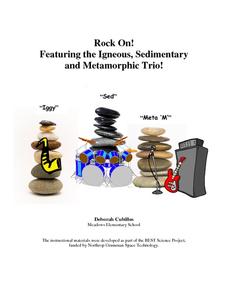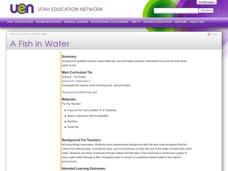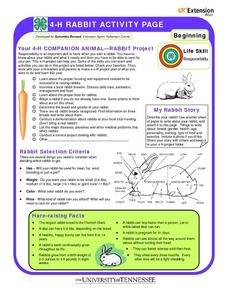Curated OER
Rock On! Featuring the Igneous, Sedimentary and Metamorphic Trio!
Get your classroom rocking with this four-lesson earth science unit. Through a series of shared reading activities and hands-on investigations, young geologists learn about the three types of rocks and the unique properties of each.
Curated OER
4-h Veterinary Science Activity Page
The 4-H teaches students about agriculture, health, and animal care - the last of which is the focus of this activity. From dogs and cats to pigs and hedgehogs, this worksheet provides helpful tips for caring for animals, as well as...
Curated OER
4-H Veterinary Science Activity Page- Life Skill
In this veterinary science activity page worksheet, students focus on the life skills associated with ethical decision making. They describe their favorite pet animal, how to care for their pet based on its needs, complete 14 true or...
National Wildlife Federation
What's Your Habitat?
How are third graders like rabbits? They both live in habitats and require food, water, and shelter to survive! An educational science lesson encourages your learners to think about their own habitats and survival needs, before comparing...
Curated OER
4-H Companion Animal Project
In this 4-H animal science activity, learners will complete several activities about companion animals. Students will learn about feline feelings, dog breeds and their different groups, rabbit vocabulary and ideas for service projects...
Curated OER
The Influence of Carbon Dioxide on the Chemistry of Soda
Students investigate the carbon dioxide content of different sodas. In this chemistry lesson, students explain why PET containers are preferable than HDPE for soda bottles. They collect data and graph them.
Curated OER
A Fish in Water
Water is essential to all living things. This classroom experiment lets everyone observe goldfish and discuss what fish need to live, like food & clean water. They then listen to the book, Fish Out of Water, and compare the fictional...
Curated OER
Goldfish Bowl
Students discover proper pet care by creating a home for a fish. In this pet responsibility lesson, students create a goldfish bowl by cutting a plastic jug in half and decorating it with markers and stickers. Students are given their...
Curated OER
4-H Cat Activity Page
As part of a unit on animals, this would be an interesting activity for upper elementary and middle school students. The 40 question activity could be linked to a research activity on animals or pets.
Curated OER
The Rainforest
Second graders investigate the five different layers of the rainforest. They conduct research to find details pertaining to the animals and the interactions of the existing food chain in each layer of the forest. Students construct a...
Curated OER
ALUMINUM RECYCLING
Students describe how aluminum is recycled. They study a diagram illustrating the recycling path of an aluminum can. They answer questions regarding aluminum. They write letters to recycling firms for information on starting a recycling...
Curated OER
Top Table
In this craft project worksheet, students gather materials and with adult help, construct a table for feeding birds. This is an advanced project.
Curated OER
Mini-Ecosystems
Third graders identify the living and non living things in a book read aloud and discuss the interactions represented in the book. Then, they research and include a list of food that each animal needs in an ecosystem. Finally, 3rd...
Curated OER
Monarch Migration
Third graders investigate the life cycle of the Monarch butterfly. They experiment with various tools to simulate the mouth parts of insects, conduct research, record their observations of butterflies hatching, write a play, complete...
Curated OER
Insects
Third graders research an insect and creates a brochure on that selected insect. Each student develops a Venn Diagram comparing similarities and differences between moths and butterflies.
Curated OER
A Fish in Water
First graders, with a goldfish as a class pet, practice the proper way to care for a pet and have responsibilities when it comes to taking care of the fish. As a class, the teacher reads the book "Fish Out of Water".
Curated OER
A Trip To the Animal Fair
Students share their experiences they have had with animals. Using photographs of their own pets, they create a booklet out of construction paper in which they identify the pets needs. They also compare and contrast what they need to...
Curated OER
I'm Not Home Alone
Students view species of plants and animals in their native habitats. They design a classroom habitat and create a plan for raising the necessary funds to accomplish their project.
Curated OER
4-H Rabbit Activity Page
As part of a unit on animals, learners could use this 4-H activity page on rabbits to explore the care of animals. There are a variety of activity suggestions related to rabbit care.
Curated OER
Cats
Students participate in an after school program that promotes communication with others, solving problems, and making decisions. They experience getting in touch with themselves, about cats, training cats, showing cats and explore...
Curated OER
Celebrate the Beauty of Wildlife
Take advantage pupils' spring fever by learning about trees and wildlife.
Curated OER
Instinct vs. Learned Behavior
Fifth graders engage in a discussion about learned vs. instinctive behaviors. They list of behaviors on the board with the help of Students. They go back through the list and use two symbols, one for instinctive and one for learned.























